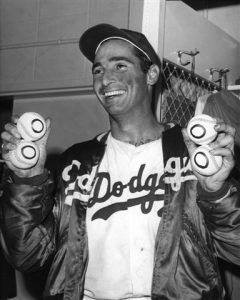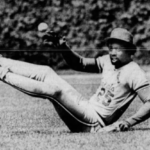Sandy Koufax
Position: Pitcher
Bats: Right • Throws: Left
6-2, 210lb (188cm, 95kg)
Born: December 30, 1935 in Brooklyn, NY
High School: Lafayette HS (Brooklyn, NY)
Schools: Columbia University (New York, NY), University of Cincinnati (Cincinnati, OH)
Debut: June 24, 1955 (11,275th in major league history)
vs. MLN 2.0 IP, 1 H, 2 SO, 1 BB, 0 ER
Last Game: October 2, 1966
vs. PHI 9.0 IP, 7 H, 10 SO, 1 BB, 2 ER, W
Hall of Fame: Inducted as Player in 1972. (Voted by BBWAA on 344/396 ballots)
Full Name: Sanford Koufax
Nicknames: The Left Arm of God
Pronunciation: \KOE-facks\
Nine Players Who Debuted in 1955
Brooks Robinson
Roberto Clemente
Ken Boyer
Rocky Colavito
Clete Boyer
Elston Howard
Sandy Koufax
Jim Bunning
Bill Virdon
All-Time Teammate Team
Coming Soon
Notable Events and Chronology
Biography
Some baseball historians object to the idea of Sandy Koufax being included among the very greatest pitchers of all time since the Dodger lefthander was a successful pitcher for only the second half of his relatively brief 12-year career. They point to the mediocre 36-40 record Koufax compiled during his first six seasons and suggest that such a mark should preclude him from being mentioned with the all-time greats. However, even Koufax’s harshest critics tend to agree with the general consensus that the Brooklyn-born lefty may well have been the most dominant pitcher in baseball history over the second half of his Hall of Fame career. Between 1961 and 1966, Koufax led all National League hurlers in wins three times, earned run average five times, strikeouts four times, shutouts three times, and complete games and innings pitched two times each. He also won three Cy Young Awards and one MVP trophy during that period, while leading the Dodgers to three pennants and two world championships. No other pitcher ever dominated the game more than Koufax did when he was at his peak. And no other player ever left the sport when he seemingly still had so much to give.
Born in Brooklyn, New York on December 30, 1935, young Sanford Braun lived in a single-parent household for six years until his mother decided to remarry when he was nine years of age. Taking the name of his stepfather, Irving Koufax, Sandy moved to Long Island with his family shortly thereafter, before the Koufaxes decided to return to the borough of Brooklyn some five years later. Koufax attended Brooklyn’s Lafayette High School, where he developed a reputation for excelling in both basketball and baseball. Although basketball remained Koufax’s first love throughout most of his teenage years, he gradually began gravitating more towards baseball after being recruited to pitch for the Coney Island Sports League’s Parkviews as a 17-year-old.
Koufax continued to play both sports while attending the University of Cincinnati, making both the freshman basketball and the varsity baseball teams. However, his attention turned primarily to baseball after the young pitcher received tryouts with the New York Giants at the Polo Grounds and the Pittsburgh Pirates at Forbes Field. During his tryout with the Pirates, Koufax made enough of an impression on Branch Rickey, Pittsburgh’s GM at the time, for the legendary general manager to tell his scout Clyde Sukeforth that the left-hander had the “greatest arm (he had) ever seen.” Nevertheless, the Pirates failed to offer Koufax a contract until he had already committed himself to the Brooklyn Dodgers.
After hearing about Koufax from a local sporting goods store owner, Dodger scout Al Campanis invited the fireballing lefthander to a tryout at Brooklyn’s Ebbets Field. With Dodgers manager Walter Alston and scouting director Fresco Thompson watching, Campanis assumed the hitter’s stance while Koufax started throwing. Campanis later said, “There are two times in my life the hair on my arms has stood up: The first time I saw the ceiling of the Sistine Chapel, and the first time I saw Sandy Koufax throw a fastball.”

The Dodgers quickly signed Koufax to a huge signing bonus, but they subsequently found themselves unable to send the inexperienced pitcher to the minor leagues after he
joined them in spring training prior to the start of the 1955 campaign. As a “bonus baby,” Koufax had to remain on Brooklyn’s major league roster for at least two years before he could be sent down to the minors. Unable to either hone his skills at the minor league level or earn a spot in the Dodgers starting rotation, Koufax languished in the Brooklyn bullpen for weeks at a time. Manager Walter Alston had little patience with the hard-throwing rookie, who found it extremely difficult to locate home plate. Hall of Fame outfielder Duke Snider was with the Dodgers when Koufax first joined the team. Snider later recalled, “When he (Koufax) first came up he couldn’t throw a ball inside the batting cage.”
Koufax saw limited playing time his first three years in the league. Working primarily out of the Dodgers bullpen during the team’s final three years in Brooklyn, he posted a combined record of only 9-10, with an ERA well over 3.00 each season. In 203 total innings of work, the struggling left-hander struck out 182 batters but also walked another 108.
Koufax occasionally showed flashes of brilliance after the team moved to Los Angeles at the conclusion of the 1957 campaign. In June 1959, he set the record for a night game with 16 strikeouts. A little over a month later, he established a new career high with 18 strikeouts, setting the N.L. record and tying Bob Feller’s major league mark for most strikeouts in a game.
Overall, though, Koufax’s performance remained extremely inconsistent. He compiled a record of 27-30 between 1958 and 1960, while posting an ERA near or above 4.00 in each of those three seasons. Koufax averaged slightly more than a strikeout an inning during that time, but he also allowed more than one walk every two innings.
Koufax became so frustrated with his lack of success that he seriously considered leaving the game before he even turned 25 years of age. But everything began to turn around for the lefthander during spring training in 1961, when Dodger catcher Norm Sherry taught him to grip the ball less tightly on the mound, and to relax his body before releasing the ball. Koufax later noted, “I became a good pitcher when I stopped trying to make them miss the ball and started trying to make them hit it.”
The results were immediate and startling. Koufax finished the 1961 campaign with a record of 18-13, an earned run average of 3.52, 255 innings pitched, a league-leading 269 strikeouts, only 96 bases on balls, and his first of six straight selections to the N.L. All-Star Team. Koufax’s 269 strikeouts broke Christy Mathewson’s 58-year-old National League mark of 267.
Koufax continued his progression during the 1962 season. Despite being limited to only 26 starts

and 184 innings due to an injured pitching hand, the 26-year-old lefthander finished 14-7, led the league with a 2.54 earned run average, struck out 216 batters, and threw his first no-hitter.
Koufax established himself as baseball’s dominant pitcher the following year. With an arsenal that included a tremendous fastball and the sharpest-breaking curveball in the sport, Koufax was practically unhittable. He captured the first of his three pitcher’s triple crowns by leading the league with a record of 25-5, a 1.88 earned run average, and 306 strikeouts. He also led all pitchers with 11 shutouts, and he placed among the leaders as well with 311 innings pitched and 20 complete games. Koufax’s fabulous performance earned him his first Cy Young Award and N.L. MVP honors, and also helped lead the Dodgers into the World Series, where they faced the vaunted attack of the New York Yankees.
Behind Koufax and the rest of their superior pitching staff which allowed New York a total of only four runs during the Fall Classic, the Dodgers ended up sweeping the Yankees in four straight games. Koufax set the tone for the entire Series in Game One, striking out a then-record 15 New York batters during the Dodgers 5-2 victory. After Los Angeles won the next two contests, Koufax returned in Game Four to clinch the Series for the Dodgers by striking out another eight Yankee batters during his team’s 2-1 victory.
After Koufax’s victory in Game Four, Yankees Manager Yogi Berra commented, “I can see how he (Koufax) won 25 games. What I don’t understand is how he lost five.”
Although the Dodgers failed to return to the World Series the following year, Koufax had another magnificent season. Despite being limited to 28 starts by pain in his pitching arm, Koufax compiled a record of 19-5, struck out 223 batters, and led the league with a 1.74 ERA and seven shutouts.
The pain in Koufax’s pitching arm grew increasingly worse in 1965. A growing arthritic condition in his elbow forced the lefthander to resort to taking pain-killers and anti-inflammatories regularly, and to soaking his arm in a tub of ice after every start. Nevertheless, Koufax was baseball’s greatest pitcher again in both 1965 and 1966. Dominating the statistical categories for pitchers, he won two more triple crowns, two more Cy Youngs, and finished second in the league MVP voting both years. Koufax led all major league pitchers in 1965 with a record of 26-8, a 2.04 ERA, 382 strikeouts, 335 innings pitched, and 27 complete games. He followed that up by topping all hurlers with a mark of 27-9, a 1.73 ERA, 317 strikeouts, 323 innings pitched, and another 27 complete games in 1966. Between 1963 and 1966, Koufax posted a combined record of an amazing 97-27.
The degree to which Koufax dominated the baseball world over the course of those four seasons earned him the admiration and respect of opponents and teammates alike.
Hall of Fame outfielder Richie Ashburn stated, “Either he throws the fastest ball I’ve ever seen, or I’m going blind.”
Philadelphia Phillies Manager Gene Mauch commented, “He (Koufax) throws a ‘radio ball,’ a pitch you hear, but you don’t see.”
Willie Stargell expressed his admiration for the lefthander by saying, “Trying to hit Koufax was like trying to drink coffee with a fork.”
John Roseboro was the Dodgers primary receiver during Koufax’s peak seasons. He recalled, “Catching him (Koufax) was like, ‘Well, we’re gonna kick someone’s ass tonight.'”
Duke Snider, who saw Koufax closeup during the various stages of the lefthander’s career, said of his former teammate, “He was a fantastic pitcher…the best I’ve seen.”
As great as Koufax was during the regular season, he was equally effective in the World Series. After leading the Dodgers to the National League pennant in 1965, Koufax refused to pitch Game One of the Fall Classic against the Minnesota Twins since the contest happened to coincide with Yom Kippur, the holiest of all Jewish holidays. Although he wasn’t a particularly religious man, Koufax believed he needed to set an example for all the young Jewish children who looked up to him. The Dodgers lost the first contest, and they fell short in Game Two as well, even though Koufax allowed only one earned run in his six innings of work. After the Dodgers rebounded by winning the next two games in Los Angeles, Koufax took over the Series. He threw a four-hit shutout in Game Five, before the Twins won Game Six back in Minnesota. Dodger manager Walter Alston then made a somewhat controversial decision before the decisive seventh game. Although he had 23-game winner Don Drysdale ready to work on full rest, Alston elected instead to pitch Koufax on only two days’ rest. Koufax rewarded the faith his manager placed in him by going the distance and allowing the Twins only three hits during the Dodgers 2-0 win. The lefthander posted a 2-1 record and a 0.38 ERA during the Series, threw two complete-game shutouts, and allowed only one earned run and 13 hits in 24 innings of work, while striking out 29 batters. Over the course of his career, Koufax compiled an ERA of 0.95 in World Series play, while striking out 61 batters and allowing only 36 hits in 57 innings of work.
After posting 49 of the Dodgers 97 victories in 1965, the tandem of Koufax and Drysdale elected to conduct a joint holdout at the end of the season. Although they ended up settling for less than the original amount they demanded from the Dodgers, the two pitchers did quite well for themselves that off-season. Koufax eventually signed for $120,000, while Drysdale’s deal for 1966 netted him $105,000.
Behind Koufax’s 27 victories, the Dodgers returned to the World Series in 1966. However, they were swept in four straight games by the underdog Baltimore Orioles, with Koufax losing his only start despite pitching fairly well. Although he allowed the Orioles only one earned run on six hits in his six innings of work, Koufax was betrayed by his defense, which committed three errors behind him during the 6-0 defeat.
The loss to the Orioles turned out to be the last start of Koufax’s career. Warnings from doctors that he would eventually lose the use of his left arm if he continued to pitch prompted the 30-year-old hurler to announce his retirement shortly after the conclusion of the World Series. Standing before the assembled media, Koufax explained, “I’ve been getting cortisone shots pretty regularly, and I don’t want to take a chance on completely disabling myself…I’ve got a lot of years to live after baseball and I would like to live them with the complete use of my body.”
Koufax ended his career with a record of 165-87, an ERA of 2.76, and 2,396 strikeouts in 2,324 innings pitched. He also allowed only 1,754 hits and threw four no-hitters, including one perfect game.
After retiring from baseball, the always guarded Koufax continued to protect his privacy. Shunning the spotlight, he relocated frequently, changing his address whenever he felt the general public had become too familiar with his whereabouts. Shortly after leaving the game, Koufax signed a 10-year contract with NBC to be a color commentator on the television station’s weekly telecasts. However, uncomfortable in front of the camera, he quit before the start of the 1973 season, one year after he became the youngest man ever elected to the Baseball Hall of Fame. Koufax subsequently remained close to the game by serving as a guest pitching coach in various training camps, including those of the Dodgers and New York Mets. He also spent 11 years working as a roving minor league pitching instructor in the Los Angeles farm system.
Of his life and career, Tom Verducci of Sports Illustrated wrote, “Koufax was the kind of man boys idolized, men envied, women swooned over, and rabbis thanked, especially when he refused to pitch Game One of the 1965 World Series because it fell on Yom Kippur. And when he was suddenly, tragically done with baseball, he slipped into a life nearly monastic in its privacy.”
@ET-DC@eyJkeW5hbWljIjp0cnVlLCJjb250ZW50IjoicG9zdF90YWdzIiwic2V0dGluZ3MiOnsiYmVmb3JlIjoiTGVhcm4gTW9yZSBhYm91dCB0aGUgdGVhbXMsIHBsYXllcnMsIGJhbGwgcGFya3MgYW5kIGV2ZW50cyB0aGF0IGhhcHBlbmVkIG9uIHRoaXMgZGF0ZSBpbiBoaXN0b3J5IC0gLSAtIC0gLSAtIC0gIiwiYWZ0ZXIiOiIiLCJsaW5rX3RvX3Rlcm1fcGFnZSI6Im9uIiwic2VwYXJhdG9yIjoiIHwgIiwiY2F0ZWdvcnlfdHlwZSI6InBvc3RfdGFnIn19@
Factoids, Quotes, Milestones and Odd Facts
Coming soon
Other Resources & Links
View Sandy Koufax’s Page at the Baseball Hall of Fame (plaque, photos, videos).
View Player Info from the B-R Bullpen
View Player Bio from the SABR BioProject
If you would like to add a link or add information for player pages, please contact us here.





